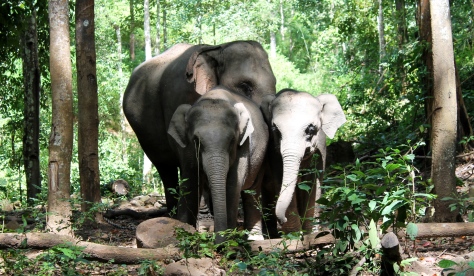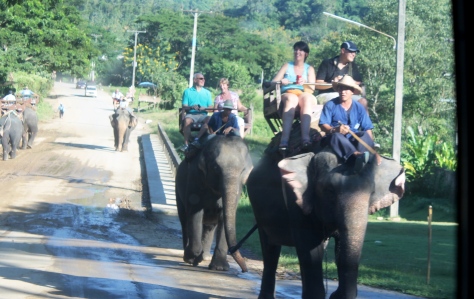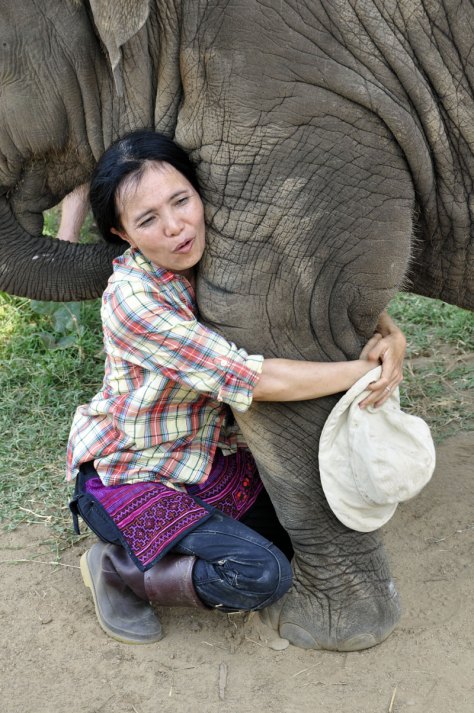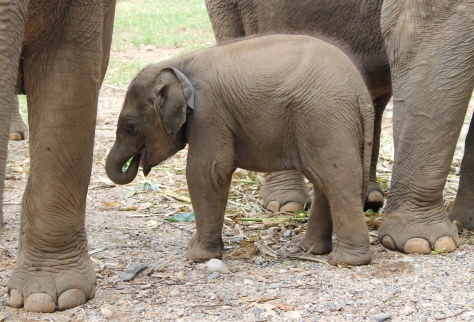
In Buddhism, elephants symbolize mental strength. At the beginning of one’s practice, a grey elephant symbolizes the uncontrolled mind. Later, after one practices dharma and meditation, a white elephant comes to symbolize the tamed mind – strong, powerful and capable of overcoming major obstacles. In this symbolism, the elephant gains strength and a capacity to overcome suffering through the taming process. However, because the elephant here is the human mind, symbolically, it gets tamed through Buddhist practice. It gains freedom through quieting, as a tamed mind better perceives the true nature of things, and such insight is needed to renounce desire and overcome suffering.
However, the idea that taming elephants can lead to a cessation of suffering falters outside of Buddhist symbolism. In reality, the way elephants are ritually tamed causes great suffering. Hill tribe communities in India and Southeast Asia—near areas where elephants have flourished—engage in a process called Phajaan, also known as “The Crush” or “breaking the elephant’s spirit”. During this ritual, humans tie a young elephant’s rear legs together, then drag him/her (with much resistance and confusion) into a wooden pen just large enough for the elephant to stand in. Then for 5-7 days, the humans furiously jab the young elephant with metal nails embedded into the end of bamboo sticks. They also dig into the flesh on the elephant’s head with bull hooks – sharp metal tools that curve and come to a vicious point – and beat at the elephant’s trunk with their fists. Individuals even climb on the elephant’s back to get it used to human riders, jabbing its ears with nails from above to show the animal who’s boss.
While the tribe people shout demands at it in some semblance of training, instead of using positive reinforcement methods to reward the elephant for good behavior, these shouts mostly cause chaos when combined with violent tactics. The elephant isn’t capable of connecting action with repercussion well, as all actions seem to lead to pain; it appears to keep struggling against its human assailants until it becomes weak enough that it can no longer fight back. These elephants are also not allowed to fall asleep for the duration of Phajaan, an element which only enhances the short and long-term physical and psychological damages the tradition can inflict. Some elephants are so scarred and changed from the ritual that, on the rare occasion that they get to see their mothers again post-Phajaan, the mothers won’t even recognize their daughter or son.
These hill tribes have traditionally broken their elephants’ spirits in order to domesticate them for use in logging or hard labor. However, now that logging is illegal in countries such as Thailand (but not in Burma), elephant owners unwilling to engage in illegal logging make up for financial losses through tourism. Partaking in elephant rides, elephant shows, and elephant treks, tourists uneducated about the training process inadvertently exploit these creatures and support their continued mistreatment.
Riding an elephant actually does damage to the elephants’ bodies. Elephants should only be ridden bareback and by one person at a time, not with wooden seats fastened to their backs. Carrying the weight of more than one person causes spinal injuries, and the seats on top of an elephant can cause blisters which can get infected. Also mahouts—people who train and ride a specific elephant from the time the animal is young—often carry a bull hook with them on tourist rides, sitting atop the elephant’s head. They use this hook to injure sensitive areas like the elephant’s mouth and inner ear, a cruel safety precaution against the animal’s wild instincts. Almost all domesticated Asian elephants have suffered through the Phajaan, a practice which domesticates but also, ironically, adds to the animals’ volatility.

Watching an elephant paint also has great repercussions, even though such shows appear to tourists as marvels of the animal’s intelligence. Mahouts train elephants to switch paintbrush directions by jabbing them in the ear with sharp tools – a body part filled with nerve endings and blood vessels.
In some cities in Thailand, baby elephants can also be found begging on the city streets, as mahouts take them to busy areas to await camera and baht (Thai currency) wielding tourists. After dealing with camera flashes that damage their eyes, the young elephants take the visitors’ bills with their trunks, handing the winnings to their mahouts. Bringing an elephant into a city is bad because they sense vibrations through their feet, a way elephants can communicate from long distances. A street-begging elephant will often rock back and forth to express its anxiety, as cars and motorbikes cause the ground to shake with unnatural vibrations.
So while elephants are revered in Thailand – the white elephant is a symbol of royal power – they are also exploited and abused. Unfortunately, the Thai government supports the continued mistreatment of these large but loving animals. Only now-wild, Asian elephants are protected as endangered under Thailand’s Conservation Act of 1992. Currently domesticated elephants are treated like livestock; they have no more protection than goats or cows. These elephants can be used for tourism, trekking, street begging, etc. without penalty as animal endangerment. Nevertheless, there are still people who illegally bring wild elephants into the tourism business, as the profits are decent. Wild elephants under the age of eight don’t need paperwork, so some elephant owners try to pass off wild-caught babies as offspring of their domesticated elephants.

Elephant Nature Park, the organization that I volunteered for during my time in Thailand, seeks to combat the abuse of elephants. Founded in 1996 by a woman named Sangduen Chailert (aka Lek), ENP provides chosen elephants a home away from dire circumstances. Located about an hour outside of Chiang Mai city, the nature park offers day trips and week long volunteer trips to tourists who want to have a productive – and no doubt touching – travel experience. Volunteers at the park pay for a working vacation, contributing both money and time to the organization and elephants. There are also cats abound on the ENP property, as well as dogs rescued from a major Thai flood.
While most volunteers stay at ENP where there are bungalows to sleep in and running water, the rural ENP program called “Journey to Freedom” offers a back-to-nature experience. If I remember correctly, the name of the program refers to when Lek brought elephants owned by the Karan hill tribe from a tourist outpost into the Thai countryside – a trek that took us six hours by vehicle to complete. Participating in the Journey to Freedom program, I spent five days living with the Karan people in a village and two days at Elephant Nature Park, along with nine other volunteers. In addition to caring for elephants, we were able to learn about Karan culture, find some respite from tech-absorbed society, and live with some genuinely kind Karan people.
The concept of the rural program is to compensate the Karan people with money and volunteer time, in exchange for their discontinued use of elephants in the tourism trade. The tribe’s mahouts stick with the elephants (ENP doesn’t replace them with their own mahouts) but they are told to refrain from using bullhooks and violent tactics to train the animals. While it’s unclear how much oversight of mahout actions there is in the rural village (this fact should be improved on), ENP is saving these creatures from an unpleasant life in tourist camps. We got the privilege of feeding, touching, and walking alongside the Karan’s elephants – about six in total – as well as getting to see them interact with one another in a wilder setting.

Volunteer work at ENP is a bit more hands-on with the elephants day-to-day than the rural program. Journey to Freedom volunteers offer their time in other ways: shucking corn, teaching English at the village’s primary school, and spending time with the people in the village when not hiking to see the eles. Volunteers at the park do more intensive work cleaning and cutting up fruit for the animals, as well as other daily duties related to the park’s easy-to-access elephants.
Gaining knowledge about Phajaan and elephant tourism practices, it’s certain that volunteering at ENP has had a profound impact upon us volunteers as human beings. In a world with such violence, how can we live more kindly?
One way to start is by passing on the knowledge of these cruel training tactics, so that friends who visit Thailand and Burma will not be tempted to ride an elephant, watch an elephant paint, or attend a circus show featuring these creatures.

Meet the ENP elephant herd here! Knowing each elephant’s personal story makes these animal abuses very real. Many suffer from post-traumatic stress disorder (PTSD) and physical deformities because of their past treatments. However, having watched these animals interact in Lek’s elephant sanctuary, it’s clear that it’s possible for them to grow away from trauma to live happy and social lives if taken care of properly.

*Note: this blog was written from a compilations of things heard, read, and watched on video at Elephant Nature Park, and on the internet during/after my travels. I am still working on compiling a proper bibliography. It is possible that facts here are incorrect. However, the main idea is clear: that we should not support elephant tourism organizations that fail to support elephants in a positive manner.
Sources: http://www.elephantnaturepark.org/index.htm
http://ngm.nationalgeographic.com/print/2005/10/thai-elephants/chadwick-text